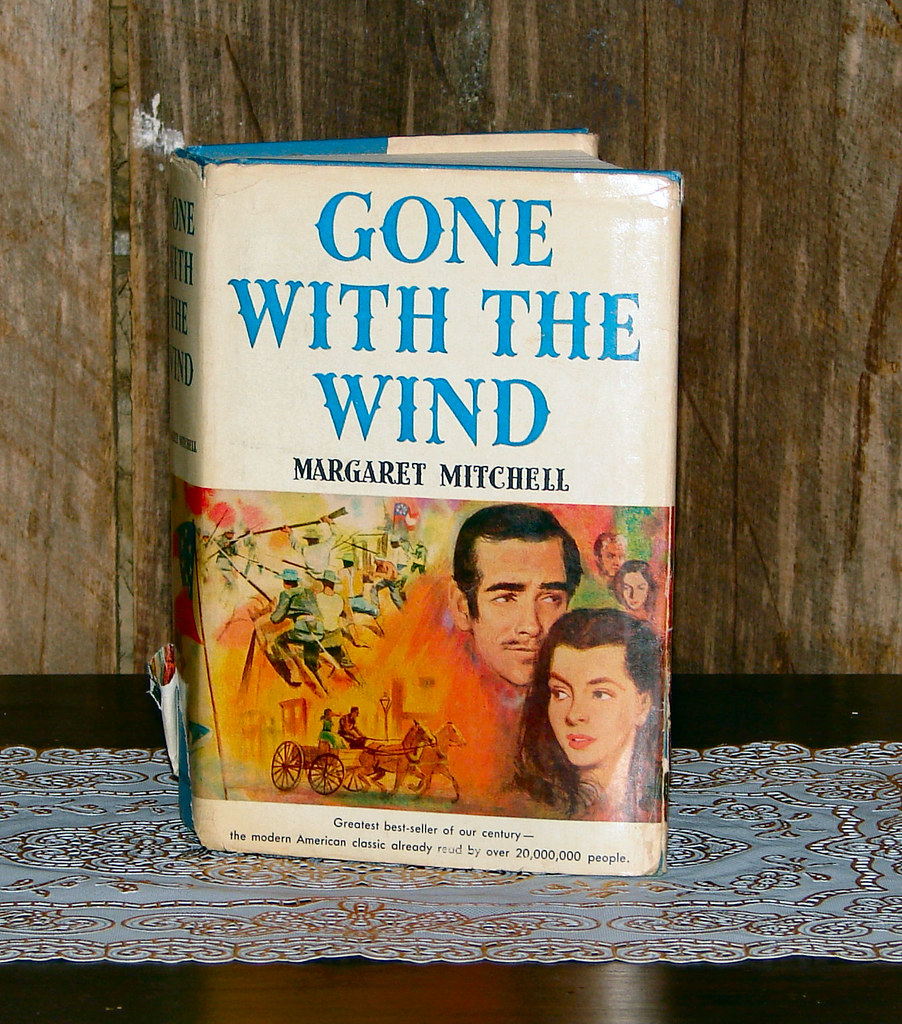A Journey Through Time and Emotion
“Gone with the Wind” is a novel that has earned its place among the great American classics, not just for its epic scope but for its ability to keep readers utterly engrossed from beginning to end. At over 1,400 pages, the sheer length of the book might seem intimidating, but Margaret Mitchell’s storytelling prowess ensures that every page is worth it. As someone who ventured into this lengthy read, I was pleasantly surprised to find that there wasn’t a single dull moment throughout the entire novel.
From the very first page, Mitchell draws you into the world of Scarlett O’Hara, a world teetering on the brink of war and social upheaval. The narrative is so richly detailed and the characters so vividly drawn that the story unfolds like a grand tapestry, each thread intricately woven into the next. What makes “Gone with the Wind” truly remarkable is how it manages to sustain this level of engagement across its expansive length. Despite the novel’s complexity and the depth of its historical context, the drama never falters, the characters never lose their grip on your imagination, and the story never loses its momentum. It’s a testament to Mitchell’s skill as a writer that this epic journey remains as compelling today as it was when it was first published.
A Masterclass in Storytelling
Margaret Mitchell’s “Gone with the Wind” is nothing short of a masterclass in storytelling. The novel is an intricate mosaic of incidents, characters, and subplots, each contributing to the larger narrative in a way that feels both seamless and intentional. Mitchell’s ability to weave together so many elements without ever losing the reader’s attention is a testament to her exceptional narrative control.
One of the most impressive aspects of the novel is how Mitchell manages to maintain a perfect balance between the personal and the historical. The grand sweep of the Civil War and its aftermath provides a dramatic backdrop, but it’s the personal stories—Scarlett O’Hara’s relentless pursuit of survival, Rhett Butler’s complex moral code, and the tragic idealism of Ashley Wilkes—that truly drive the narrative. Each character’s journey is interwoven with the larger historical events, creating a rich, layered story that resonates on multiple levels.
The pacing of the novel is another key to its success. Despite its length, “Gone with the Wind” never drags. The story is constantly propelled forward by the unfolding drama, whether it’s Scarlett’s tumultuous love life, the struggles of the South during Reconstruction, or the shifting fortunes of the O’Hara family. Even the subplots, such as Melanie Wilkes’ quiet strength and loyalty or the impact of war on the Southern way of life, are so compelling that they could stand alone as fascinating stories in their own right.
Specific incidents, like the burning of Atlanta or the harrowing aftermath of the war, are written with such vivid detail and emotional intensity that they leave a lasting impact on the reader. These moments, combined with the novel’s overall narrative structure, make “Gone with the Wind” an unforgettable reading experience that showcases Margaret Mitchell’s unparalleled storytelling abilities.
Capturing the Civil War Era
One of the most striking achievements of “Gone with the Wind” is how vividly it captures the Civil War era in the United States. Margaret Mitchell does more than just set her story against the backdrop of the war; she immerses the reader in the tumultuous events of the time, bringing the period to life with meticulous detail and emotional depth. Through the eyes of Scarlett O’Hara and the other characters, we experience the profound impact of the war on the South, both in terms of its physical destruction and its effect on the social fabric of the region.
Mitchell’s portrayal of the Civil War is notable for its historical accuracy, reflecting the complexities and contradictions of the time. She doesn’t shy away from depicting the harsh realities of war—the devastation of cities like Atlanta, the desperation of those left behind, and the brutal consequences of defeat. Yet, she also captures the resilience of the Southern people, their ability to adapt and survive even in the face of overwhelming adversity.
What makes Mitchell’s depiction of the era particularly compelling is how she balances these historical events with the personal drama of her characters. The Civil War is not just a backdrop; it’s an integral part of the story that shapes the lives, decisions, and destinies of Scarlett, Rhett, and the others. By intertwining the historical with the personal, Mitchell makes the Civil War era accessible and engaging, providing readers with a deeply human perspective on one of the most significant periods in American history.
Emotionally Charged Drama
The emotional depth of “Gone with the Wind” is one of the key elements that elevates it to the status of a great American novel. Margaret Mitchell expertly captures a wide range of complex emotions, from love and ambition to despair and resilience, without ever allowing the drama to become overwhelming or melodramatic. This delicate balance is a testament to Mitchell’s understanding of her characters and her ability to portray their inner lives with nuance and sensitivity.
At the heart of the novel are the relationships between Scarlett O’Hara, Rhett Butler, and Ashley Wilkes—three characters whose lives are intricately intertwined in a web of love, jealousy, and unfulfilled desires. Scarlett’s relentless pursuit of Ashley, despite his clear devotion to his wife Melanie, creates a tension that underpins much of the novel’s emotional intensity. Her obsession with Ashley represents more than just unrequited love; it’s a symbol of her refusal to accept the changing world around her, clinging instead to a past that is slipping away.
Rhett Butler, with his cynical yet passionate nature, serves as both Scarlett’s foil and her greatest challenge. Their relationship is a tumultuous dance of attraction, conflict, and deep-seated affection, culminating in one of literature’s most famous and heart-wrenching partings. Rhett’s love for Scarlett, though often hidden behind a veneer of indifference, adds a layer of tragedy to the narrative, as he ultimately realizes that his love cannot change who she is.
The emotional intensity of “Gone with the Wind” is further heightened by the backdrop of war and its aftermath, which strips away the characters’ illusions and forces them to confront harsh realities. Mitchell’s ability to convey these emotions in a way that feels authentic and deeply human is what makes the novel resonate so powerfully. It’s a story that captures the full spectrum of the human experience, making it a timeless classic that continues to move readers with its emotional depth and complexity.
The Challenges of a Lengthy Read
At over 1,400 pages, “Gone with the Wind” is undeniably a lengthy read, and for many, this can be a daunting prospect. The sheer size of the novel might deter new or casual readers, who may feel overwhelmed by the commitment required to tackle such an epic work. However, for those who appreciate detailed storytelling and rich character development, the novel’s length is not a hindrance but rather an opportunity to fully immerse oneself in the world Mitchell has created.
What makes “Gone with the Wind” worth the effort is its ability to maintain a captivating narrative throughout. Despite its length, the novel is carefully structured to ensure that the story never loses momentum. Each chapter builds upon the last, weaving together the lives of the characters with the historical events that shape their destinies. Mitchell’s writing is so engaging that even the most seemingly mundane moments are infused with significance, keeping the reader invested from beginning to end.
For readers who are willing to take on the challenge, “Gone with the Wind” offers a reading experience that is both deeply rewarding and unforgettable. The novel’s length allows for a depth of exploration that shorter works simply cannot achieve, making it a masterpiece of American literature that is well worth the time and effort it demands.
Not for the Faint of Heart: Who Should Read It
“Gone with the Wind” is not a novel for everyone, and that’s okay. Its length, complexity, and emotional intensity mean that it requires a certain level of commitment and patience from its readers. For new or casual readers, the novel may feel overwhelming, and its demanding nature might not be a good fit. However, for those who enjoy richly detailed, character-driven stories that offer deep emotional engagement and a sweeping historical backdrop, “Gone with the Wind” is an unparalleled experience.
This novel is particularly suited for readers who appreciate the intricacies of human relationships, the exploration of moral and ethical dilemmas, and the vivid portrayal of a pivotal moment in American history. If you’re someone who loves to get lost in a long, immersive story with complex characters and a plot that keeps you hooked from start to finish, then “Gone with the Wind” is a must-read.
Final Thoughts: A Timeless Classic
“Gone with the Wind” stands as one of the great American novels, not just for its epic scope, but for its masterful storytelling, emotional depth, and vivid portrayal of the Civil War era. Margaret Mitchell’s ability to weave a compelling narrative that captivates from start to finish is a testament to her skill as a writer. This novel offers an unforgettable journey through time, filled with complex characters and dramatic twists that leave a lasting impact. For those who are willing to take on the challenge, “Gone with the Wind” is a timeless classic that remains as relevant and powerful today as ever.



